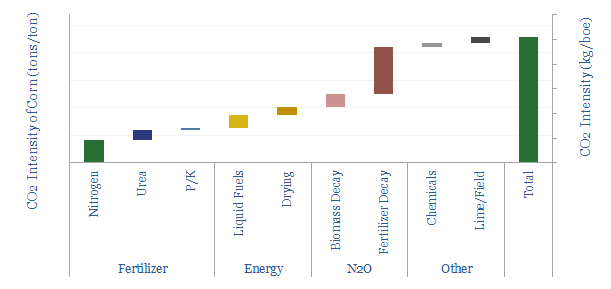The CO2 intensity of crop production is broken down in this datafile. We have focused our numbers on corn production, as it is the world’s largest crop, with production of around 1.2 GTpa, or c5,500 TWH of primary energy. (Amazingly, corn thus comprises about 25% of all human food-energy production; and 3% of all total human energy production, 2x more than all wind and solar energy in 2021 combined).
The CO2 intensity of producing corn averages 0.23 tons/ton, or 75kg/boe. This is relatively low, compared to industrial commodities, that tend to range from 0.5 – 150 tons/ton CO2 intensity, across our economic models.
The largest component of crop’s CO2 intensity, at c50% of the total, is N2O emissions, as c0.3-3.0% of all nitrogen fertilizers break down into N2O (per the IPCC). N2O is a greenhouse gas with 298x higher global warming potential than CO2, which explains around 7% of total US greenhouse gas emissions (per the EPA).
Another 30% of the total emissions footprint for producing crops is from producing fertilizers themselves, such as ammonia and urea.
Another 10% is liquid fuels, mainly diesel, used in farm machinery, for tillage, sewing seeds, harvesting crops and transporting them to a processing/storage facility.
Our base case estimate of 75kg/boe of Scope 1+2 CO2 intensity for crop production is interesting, as it is actually higher than the Scope 1+2 CO2 intensity of producing oil and CO2 intensity of producing gas.
The energy return on energy invested for crop production is around 12x on this model. Or in other words, for each 1 kWh of energy in the corn crop, around 0.09 kWh must be supplied, of which c6pp is in the form of natural gas and 3pp is in the form of oil products, mainly diesel. It is sometimes said that the modern agricultural system can be described as the conversion of fossil energy into food energy. Or numbers would suggest this statement is about 9% true!
Implications for biofuels. Making 1 boe of bio-ethanol requires around 2 boe of corn, plus additional gas, electricity and the re-release of CO2 from fermentation. Thus we can compile a total look-through CO2 footprint for corn ethanol, including data from actual bio-ethanol plants and our corn ethanol economic model. We think the Scope 1-3 CO2 of corn ethanol is 240kg/boe, or around 50% below conventional oil products. Although this does not include opportunity costs of biofuels, for example, the potential to re-forest croplands growing corn for ethanol, which could abate over 5 tons of CO2 per acre per year.
All of our numbers can be stress-tested in the data-file. The numbers can vary markedly, from 0.1 – 0.4 tons CO2/ton of corn; or in other words, from 40kg/boe to 160kg/boe. Agricultural improvements remain an important part of the energy transition.

